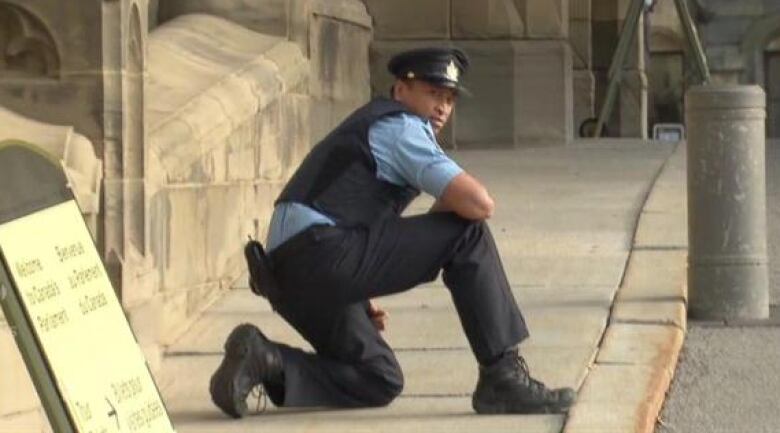Attack on Parliament exposed 'systemic' security gaps, says ex-JTF2 commander
Former counterterrorism boss says Canada's security 'silos' are outdated
Even though security officers did a "brilliant job" of responding to last month's attack on Parliament Hill, Canada's national security infrastructure is fragmented and needs to be updated, according to a former commander of Canada's special forces.
Retired lieutenant-colonel Steve Day, a former leader of the elite JTF2 counterterrorism unit, was asked by the CBC to undertake a frame-by-frame review of CBC News and security video footage captured during the Oct. 22 attack on Parliament Hill by Michael Zehaf-Bibeau.
- EXCLUSIVE VIDEO: Reconstructing the Centre Block shootout
- Shooting on Parliament Hill: What CBC's raw footage shows
- Parliament Hill security confusion left MPs locked out
- RCMP, House security radios on different frequencies
Day found "systemic" flaws but concluded that the officers on the scene, despite a lack of specialized training, acted properly in containing the threat.
Zehaf-Bibeau died in a hail of gunfire outside the Parliamentary Library after first shooting Cpl. Nathan Cirillo at the National War Memorial, then wounding a security guard at the entrance to the Centre Block on Parliament Hill.
8 bullets
Day's analysis of the tape suggests that Zehaf-Bibeau probably exhausted the maximum number of bullets that could be loaded into his Winchester .30-30 rifle in the moments before he died.
- Three at the War Memorial.
- One that wounded Samearn Son, the guard at the front entrance.
- At least two more at the rotunda near the entrance.
- Another two in the Hall of Honour as he ran toward the library
If correct, this means Zehaf-Bibeau would have needed to reload, with officers closing in on him, before firing what Day says is one final shot.
That can be heard on CBC News videotape, just before he was cut down by semi-automatic pistol fire from Sergeant-at-Arms Kevin Vickers and other officers.
'Incredibly difficult shot'
Day finds no fault with those officers for not bringing the gunman down sooner, saying that pistols are only accurate at close range and that Zehaf-Bibeau had taken cover after running down the Hall of Honour.
"Really, that lethal range from a pistol is about 25-30 metres at best — and to take a 50-metre pistol shot is an incredibly difficult shot to take."
However, Day adds that the fragmentation of forces on Parliament Hill, and the lack of surveillance at the entrance to the Hill, were both handicaps that need to be fixed.
Pointing to security footage of Zehaf-Bibeau running unchallenged onto the Hill with his rifle, Day said that the Hill should still be open to the public, but that a security officer watching the entrance would have changed everything.
"If there would have been a police officer at those bollards when the shooter first departs his car, we've got a different scenario," he said, referring to barriers that stop vehicles, but not people, from entering the grounds.
Day said the eyes of an officer, combined with better monitoring and surveillance technology, could have provided early warning to officers inside the Parliament Buildings so that the doors could have been locked.
Instead, Day added, the video shows many officers did not know what was happening and that the various forces involved need to be "networked" to respond more coherently.
Silos and stovepipes

The Senate and House security guards are under separate commands. The Ottawa police, the RCMP and its plain-clothes protective detail for the prime minister were also involved.
Day said this fragmentation of agencies is reflected in Canada's security infrastructure as a whole.
"This is symptomatic of some of the larger issues that we have in Canada with respect to moving our architecture and our lens from the 20th century and the Cold War paradigm into the 21st century and an adversary that is globally networked."
As it stands, Day added, "it's siloed and stovepiped. So, inside Public Safety, inside DND (Department of National Defence) and inside Foreign Affairs, you've got silos of information that don't necessarily translate down to the folks on the shop floor."
"It's not necessarily the individual officers that's the problem, as it is a systemic issue about how we bring together those different security forces, actors, so that we've got a coherent approach."

